
SHOPPING FOR CAST IRON
There are many practical advantages to using bare cast-iron cookware. Knowing these facts can help you make the most of your pans.
Improves with use Every time you cook in a cast-iron pan, the oils in the food contribute to the seasoning. That means the skillet Grandma uses every day will probably perform better than a new one.
Naturally nonstick Cast iron is the original nonstick pan thanks to the oils used to cook with and care for it. (See Seasoning in chap. 5 for details.)
Superior heat retention Adding room-temperature food to a hot pan normally lowers the pan’s temperature—but not with cast iron. Once it’s hot, it stays hot. This not only affects the cooking time but also helps eliminate hot spots, which can cause food to burn. This makes cast iron ideal for high-heat cooking, like searing steaks.
Heavy This may sound like a negative attribute, but the weight of the pan helps ensure excellent heat retention. In addition, the heavy lid traps in heat and moisture far better than its glass or lightweight counterparts. (This is why the Dutch oven is referred to as the original pressure cooker.)
Nearly indestructible If these pans could survive the Oregon Trail, they can survive your kitchen. Seriously.
Easily restored Don’t throw away that rusty pan! You can probably restore it. (See From Rust to Wonderful in chap. 5 to learn how.)
Versatile Whether you’re frying eggs or making filet mignon, your cast-iron pan is the perfect option. You can even take it straight from the stove to the oven, or vice versa, which is impossible with most cookware.
Essential If you like to camp or go on mission trips, or if you’re prepping for hurricane season (which we do every year), a cast-iron pan is an essential item. It will allow you to cook outdoors over an open flame as easily as you can over an electric stove.
Inexpensive You can get a new twelve-inch bare cast-iron skillet from Lodge for as little as twenty-five dollars. Considering that cast iron will last you a lifetime, and you only need a couple pieces to stock your kitchen, it’s much less expensive than alternative cookware.
Modern Cast-Iron Options
Because cast iron is the perfect material for cooking so many dishes, you can find it in a wide assortment of shapes and sizes, from the traditional skillet to Bundt pans. Here’s a list of some of the more popular pieces available today.
Skillets Common sizes are nine, ten, and twelve inches, which is the measurement of the diameter of the top rim of the pan (not the bottom). The nine-inch skillet is perfect for pies since store-bought pie shells are usually that size. A ten-inch skillet is plenty big enough if you’re cooking for two, but a twelve-inch skillet is nice if you need some more room.

Some nice features to look for are helper (or assist) handles and pour spouts. Remember, cast iron is heavy, so being able to hold it with two hands and easily pour out contents can be very useful. If you need something more compact,
Lodge’s Dual-Handle Pans provide all the benefits of a regular skillet with two small loop handles instead of the long traditional handle.
If you intend to do a lot of frying, though, look for a deep skillet. These may be measured by the diameter or by the capacity (in quarts).

Griddles You can make pancakes in a skillet, but it’s a lot easier to flip them if you have a griddle with really low sides. Round griddles can cook a couple pancakes at a time and can be heated on a single burner. Longer, rectangular griddles hold more food and can be heated over two burners at once.

Grill pans No grill? No problem. With a grill pan, you can “grill” steaks, chicken, fish, and more on your stove top. Yes, you can use a regular skillet, but a grill pan will enable the food to sit up a bit, out of its own juices, and give you those nice grill marks.
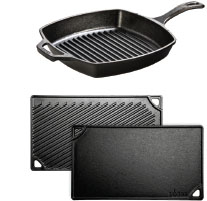
If you’re interested in both a griddle and a grill pan, you might want to check out the Double Play Reversible Grill/Griddle from Lodge. (I love mine!)
Cornbread pans Here in the South, these pans deserve their own category. Yes, you can make a delicious cornbread in a traditional skillet, but it’s more fun to use a wedge pan, which divides the cornbread into eight perfect triangles. My favorite, though, is the cornstick pan, which makes five to seven cornbread sticks in the shape of corn on the cob.

Bakeware It may surprise you, but cast iron’s ability to retain and distribute heat makes it ideal for baking desserts. Cake pans, mini cake pans, muffin pans, brownie pans, loaf pans—you can find all of these in cast iron. In fact, Lodge just resurrected its fluted cake pan, which it had discontinued in the late 1990s. This is the first item in the new Legacy series, so I’m curious what will be brought back next year.

Dutch ovens Dutch ovens are essentially large pots that can retain heat and moisture extremely well. Instead of inches, Dutch ovens are measured in quarts. Although five-, six-, and seven-quart ovens are the most popular, you can find them as small as one quart (for serving) and as big as nine quarts or more.
While all bare cast iron can be used over an outdoor fire, camp Dutch ovens are made specifically for this purpose. The food is cooked in one of two ways: (1) suspending the oven over an open flame or (2) baking the food from the top and bottom by placing the oven in hot coals and then adding more coals on top of the lid. This is why camp Dutch ovens usually come with a handle for hanging, three small feet to lift it above the coals, and a flat lid with a brim to hold additional coals. Robby’s parents have two camp Dutch ovens that have been in the family for years, and Mary Frances still uses one to make biscuits when they go camping in the fall.

Enamel cookware While the core of these pieces is cast iron, both the inside and outside are coated in enamel, which is essentially a glass glaze. Usually, the interior is a matte white or black, while the outside is a vibrant color.
Since the cast iron is completely coated, there is no need to season the pan, which means you can wash it with soap after every use. However, you’ll want to avoid metal utensils and abrasive brushes and cleansers because these can chip away at the enamel, making the pan unusable (because you don’t want to eat glass chips).

Since seasoning isn’t an issue with enamel cookware, it’s most useful when cooking acidic foods like tomato-based soups and casseroles, which can eat away at the seasoning of bare cast iron over time. This is why I have one enamel Dutch oven in my collection, which I use on a weekly basis. (She has such a pretty red finish that I lovingly refer to her as Ruby.)
Since 1925, Le Creuset has dominated the market in enamel cookware, offering beautiful Dutch ovens, casserole dishes, skillets, bakeware, and more. However, Lodge has now released its own line of enamel cookware that is just as pretty and efficient.
You may hear of some health concerns regarding enameled cast iron because lead and other heavy metals are used during the manufacturing process. However, those metals are used to create the brightly colored hues used on the exterior of the pans, not the interior coating.
Rust resistant Have you ever ordered a meal or dessert at a restaurant and had it served in a cast-iron dish? Since cast iron keeps hot foods hot and cold foods cold, they can be ideal servers. However, restaurants use dishwashers to clean their tableware.
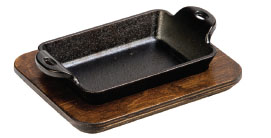
With this in mind, Lodge introduced a new line of heat-treated iron. These cast-iron servers are taken through a patented heat-treating process that inhibits rust, allowing them to be cleaned in the dishwasher. You read that right—these little guys can go straight into the dishwasher! Just like regular cast iron, though, the seasoning does need to be maintained.
If you’ve shopped for cast-iron pans recently, you may have seen some labeled “lightweight cast iron.” These pans, which entered the market in recent years, are made of the same material as traditional cast iron. However, the molds used to manufacture the pans are made of metal instead of sand. This allows the pans to be made much thinner than regular cast iron. The pans may also be machined or milled to thin them further.
To lessen the weight even more, the handles on these pans are not integrated like they are on traditional cast iron pieces. Instead, the handles are manufactured separately of other metals or wood and then riveted onto the pan.
The result is cookware that can be up to 50 percent lighter than traditional cast-iron pans, making them easier to lift. But there are drawbacks.
The heavy weight of traditional cast iron allows for superior heat retention and helps with heat distribution. The folks at America’s Test Kitchen proved that lightweight cast iron heats up and cools down faster, making it less than ideal for high-heat cooking. It also fails to transfer heat well, resulting in hot spots that cook unevenly.
As for durability, there’s no contest. Lightweight cast iron is more prone to cracking and splitting than traditional cast iron, and the handles are more likely to break off.
If you really want to use cast iron but you can’t handle the weight of it, a good quality lightweight cast-iron pan may be a decent alternative. However, another option is to simply use smaller pans that you can handle more easily (which is what I do).
Cast-iron cookware used to be so important to the everyday home that it was passed down like a family treasure from one generation to the next. In fact, George Washington’s mother specifically noted her cast iron “furniture” in her will.
If you’re fortunate enough to have your grandmother’s cast iron, don’t treat it as an antique. Instead, restore it if necessary and use it daily. That’s the best way to keep it in prime condition (and honor your grandmother in the process).
However, if you’re like most of us, you’ll need to start your cast-iron collection from scratch. The good news is that you probably need only a couple pieces: a large skillet and an enameled Dutch oven will do. Between the two, you can make just about anything, including the recipes in this book. Cast iron is also readily available in big-box stores, specialty stores, online retailers, and even supermarkets. And if you really want an older piece that’s stood the test of time, you can probably find one in your local secondhand store.
Here are some tips to keep in mind as you shop for your cast-iron cookware.
BUYING NEW
Bare cast iron Look for products made in the United States. It’s not uncommon for foreign companies to take shortcuts that weaken the iron, making them more likely to cook unevenly, warp, or crack.
Also, try to determine what oil the company used for the seasoning, as some manufacturers may introduce inedible chemicals.
Enameled cast iron There are so many regulations around the manufacturing process of enameled cookware that there are no manufacturing companies here in the United States to do the job. To make these pans, US companies must work with overseas companies, so don’t be surprised if the tag says “Made in China.” However, to ensure you’re getting the safest, most reliable product, buy from a trusted brand like Lodge or Le Creuset. If the enamel cracks for some reason, these companies are more likely to stand by their products.
Regardless of the brand you choose, be sure to avoid pans with chemical nonstick interiors, even if they have pretty enamel-coated exteriors. What touches your food is always more important than what’s on the outside of the pan.
•Never buy any pan that looks warped or cracked.
•If you see a pan you really like, but it’s rusted or has built-up gunk on the inside, it may be a good find if you’re willing to put in the effort to restore it. (See From Rust to Wonderful in chap. 5 for details.)
•You may notice numbers or letters on the bottom of the pan. These can represent anything from the size of the stove-top burner the pan was designed for, the pattern the manufacturer used to create the pan, or even the individual molder who made the pan. What these markings will not do is tell you the size of the pan; for that, you’ll need to measure the diameter of the top rim of the pan (not the bottom).
•If you see a pot with three small feet, it’s a camp Dutch oven. These are great for outdoor cooking, but they won’t work on your indoor stove.
•Want to know who the manufacturer is, but it’s not listed? That’s not uncommon. Cast-iron manufacturers didn’t brand their names into their pans for many years. However, if you do see markings on the pan, you can perform an online search to determine which company made it. You may even be able to tell when it was made.
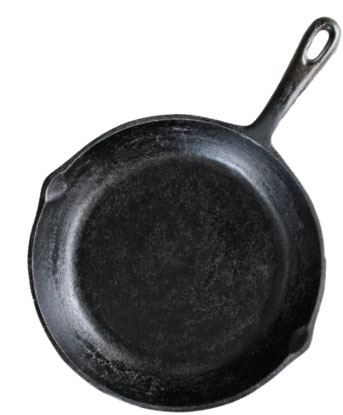
There are a few accessories that can make cleaning and cooking with cast iron a little easier. Here’s a list of the most common ones.
CLEANING
Scrapers In my opinion, these are a must-have! Use them to scrape bits of food off the pan while it’s cold or hot. The polycarbonate scrapers from Lodge are really nice because they’re sturdy and have different angles that curve to the shape of the pan. The grill scraper even has “teeth” that fit perfectly in the grill pans.
Scrub brush After loosening any stuck-on food with a scraper, I reach for a brush with nylon bristles to finish the job. A little scrub under hot water is usually all it takes to clean a skillet.

Chainmail scrubber Folks rave about these scrubbers, which are supposed to remove stuck-on food without damaging the seasoning. Lodge’s version includes a silicone interior to make it more rigid (like a thick sponge). Personally, I find the scrapers and scrub brushes more than sufficient, but you may prefer the chainmail.

Seasoned Cast Iron Care Kit Lodge has made it easier than ever to care for its cast-iron cookware. It has combined a polycarbonate pan scraper, silicone handle, mini scrub brush, and seasoning spray into a single care kit. The spray is 100 percent canola oil without additives or propellants. I use these pieces daily to care for my cast iron.
COOKING
Silicone handle holders and oven mitts My mom once had a traditional, insulated handle holder melt onto her cast-iron pan—not good! We now use only silicone handle holders, which provide protection up to 450 degrees Fahrenheit and come in a range of colors and sizes to fit any pan. Lodge even sells holders now for its helper handles, which I highly recommend. Just remember to put the holder on the handle before you turn on the stove so you don’t accidentally burn yourself.
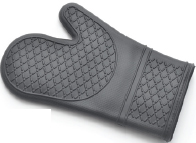
Since handle holders are not intended to be used in the oven, you’ll also need an oven mitt. I suggest one made with silicone to provide extra protection.
Glass lids Heavy cast-iron lids are extremely efficient at trapping in heat and moisture. When your recipe calls for something different—or you just want the ability to see your food while it’s cooking—a tempered glass lid is a great option.

Fry baskets If you want to deep-fry chicken or make homemade doughnuts, a fry basket can be extremely helpful. Lodge sells various sizes to fit its Dutch ovens.
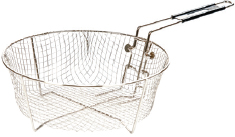
Splatter screens Place one of these lightweight screens on top of the skillet while you’re cooking to prevent hot liquids from splattering on you.
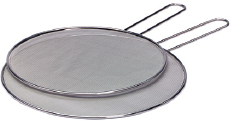
Trivets There are a lot of dishes that are best served right from the cast-iron pan (a few of which are listed in this book). However, that means you’re going to need a good trivet to keep the hot pan from destroying your dining table or linens. Metal, wood, and silicone are all good materials for trivets. Lodge even offers magnetic silicone trivets that move with your pan (very cool!).
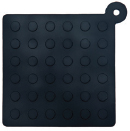
Utensils Essential items for skillets, griddles, and grills include stainless steel flippers, spatulas, and tongs. One of my favorites is a combination tong and turner, which is perfect for flipping thick steaks or grilled cheese sandwiches. Don’t worry about metal utensils on bare cast iron; they won’t scratch off the seasoning because it’s chemically bonded to the iron. However, you’ll need to use wood or silicone when cooking in enameled cast iron so you don’t chip the enamel. If you have a Dutch oven, you’ll also need large spoons and ladles to dish up your favorite soup or pot roast.

Electric burner If you have any issues with your stove, an extra electric burner (sometimes called a “fifth-eye burner”) can be quite handy. My mother-in-law uses hers when she needs to free up some space on her stove top. You can find basic coil and induction burners in retail stores and online for about forty dollars.
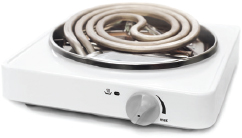
Glass storage containers You don’t want to store food in bare cast iron because the acids will eventually eat away at the seasoning. Instead, I recommend you invest in at least one glass storage container that holds the same amount as your largest skillet or Dutch oven, as well as a few smaller containers. My favorites are from Rubbermaid and Pyrex.
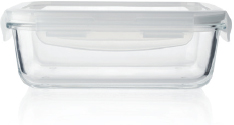
STORING
Divider pads These soft pads are a must if you want to stack your enameled cast iron. You can also use them in between your bare cast-iron pots and lids to allow air to flow (although a kitchen towel will serve just as well).
ACCESSORIES TO AVOID
Any cleaning or cooking utensil made of cheap plastic These can melt or flake into the pan and make its way into your food. (I’ve had a plastic scraper melt onto the pan while I was cleaning it, and a plastic spatula melt while cooking. Lesson learned!) Instead, choose high-quality silicone, stainless steel, or wood.
Handle holders with soft synthetic materials on the inside If the temperature gets too hot, these can melt right onto the handle.
Metal utensils in enameled cast iron These can scratch the enamel coating. However, metal utensils are perfectly safe in bare cast iron.